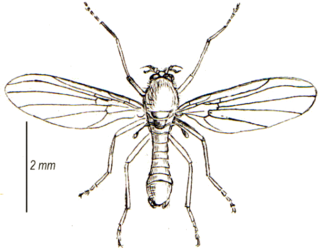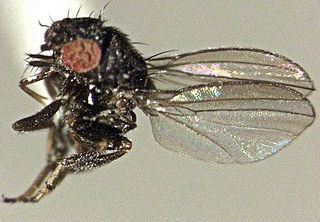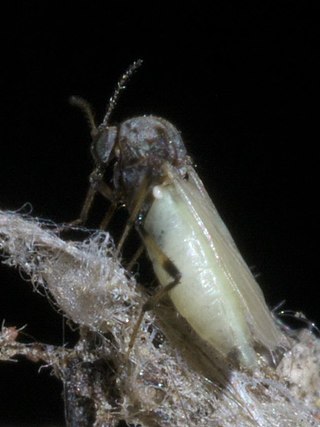
Hydrophilidae, also known colloquially as water scavenger beetles, is a family of beetles. Aquatic hydrophilids are notable for their long maxillary palps, which are longer than their antennae. Several of the former subfamilies of Hydrophilidae have recently been removed and elevated to family rank; Epimetopidae, Georissidae, Helophoridae, Hydrochidae, and Spercheidae. While the majority of hydrophilids are aquatic, around a third of described species are terrestrial, mostly belonging to the subfamily Sphaeridiinae.

A midge is any small fly, including species in several families of non-mosquito Nematoceran Diptera. Midges are found on practically every land area outside permanently arid deserts and the frigid zones. Some midges, such as many Phlebotominae and Simuliidae, are vectors of various diseases. Many others play useful roles as prey for insectivores, such as various frogs and swallows. Others are important as detritivores, and form part of various nutrient cycles. The habits of midges vary greatly from species to species, though within any particular family, midges commonly have similar ecological roles.

Culicoides imicola is a species of Ceratopogonidae that transmits the bluetongue virus (BTV) and the African horse sickness virus. This particular species has been recorded in Africa, Asia and Europe. African midges feed on animal blood, including horse, cattle, and sheep. Unlike other species within the Culicoides genus, this species prefers drier habitats for egg laying but retains a preference for moist soil to support larvae growth. Other suspected BTV vectors are Culicoides (Culicoides) pulicaris and species in the Culicoides (Avaritia) obsoletus complex.

Leptoconops torrens is a species of small biting flies in the no-see-um family Ceratopogonidae. They were first mentioned in writing by Charles Henry Tyler Townsend in 1893. The name Leptoconops carteri is a junior synonym of L. torrens. They are prevalent in the southwestern and southeastern areas of the United States. In early stages of life, L. torrens flies dwell in soil, then emerge to feed and breed as fully developed adults.

A black fly or blackfly is any member of the family Simuliidae of the Culicomorpha infraorder. It is related to the Ceratopogonidae, Chironomidae, and Thaumaleidae. Over 2,200 species of black flies have been formally named, of which 15 are extinct. They are divided into two subfamilies: Parasimuliinae contains only one genus and four species; Simuliinae contains all the rest. Over 1,800 of the species belong to the genus Simulium.

Ceratopogonidae is a family of flies commonly known as no-see-ums, or biting midges, generally 1–3 millimetres in length. The family includes more than 5,000 species, distributed worldwide, apart from the Antarctic and the Arctic.

Thaumaleidae, the solitary midges or trickle midges, are a group of nematoceran flies related to the Ceratopogonidae, Chironomidae, and the Simuliidae. They are small, stocky, yellow to brown flies (3–4 mm). Very few species are known for this family. Larvae are found in films on rocks and the nonfeeding adults are usually found on foliage along the same streams in which the larvae are found. A few solitary midges are found in the Southern Hemisphere, but Thaumaleidae are generally an Holarctic family.

The Chironomoidea are a superfamily within the order Diptera, suborder Nematocera, infraorder Culicomorpha. This superfamily contains the families Chironomidae, Ceratopogonidae, Simuliidae, and Thaumaleidae.

Nepenthesinfauna are the organisms that inhabit the pitchers of Nepenthes plants. These include fly and midge larvae, spiders, mites, ants, and even a species of crab, Geosesarma malayanum. The most common and conspicuous predators found in pitchers are mosquito larvae, which consume large numbers of other larvae during their development. Many of these animals are so specialised that they cannot survive anywhere else, and are referred to as nepenthebionts.

Papilio demodocus, the citrus swallowtail or Christmas butterfly, is a swallowtail butterfly which commonly occurs over the entirety of sub-Saharan Africa, including Madagascar, besides the southern Arabian Peninsula. The caterpillars feed on various native plants of especially the family Rutaceae, but have also taken to the leaves of cultivated citrus trees.

Milichiidae are a family of flies. Most species are very small and dark. Details of their biology have not yet been properly studied, but they are best known as kleptoparasites of predatory invertebrates, and accordingly are commonly known as freeloader flies or jackal flies. However, because of the conditions under which many species breed out, they also are known as filth flies.

The Chrysomelinae are a subfamily of leaf beetles (Chrysomelidae), commonly known as broad-bodied leaf beetles or broad-shouldered leaf beetles. It includes some 3,000 species around the world.

Culicoides is a genus of biting midges in the family Ceratopogonidae. There are over 1000 species in the genus, which is divided into many subgenera. Several species are known to be vectors of various diseases and parasites which can affect animals. Like Leptoconops, the genus has a long fossil record, with earliest known fossils being from Burmese amber, around 99 million years old.

Athericidae is a small family of flies known as water snipe flies or ibis flies. They used to be placed in the family Rhagionidae, but were removed by Stuckenberg in 1973. They are now known to be more closely related to Tabanidae. Species of Athericidae are found worldwide.

A wasp is any insect of the narrow-waisted suborder Apocrita of the order Hymenoptera which is neither a bee nor an ant; this excludes the broad-waisted sawflies (Symphyta), which look somewhat like wasps, but are in a separate suborder. The wasps do not constitute a clade, a complete natural group with a single ancestor, as bees and ants are deeply nested within the wasps, having evolved from wasp ancestors. Wasps that are members of the clade Aculeata can sting their prey.

Ropalidia marginata is an Old World species of paper wasp. It is primitively eusocial, not showing the same bias in brood care seen in other social insects with greater asymmetry in relatedness. The species employs a variety of colony founding strategies, sometimes with single founders and sometimes in groups of variable number. The queen does not use physical dominance to control workers; there is evidence of pheromones being used to suppress other female workers from overtaking queenship.

Mischocyttarus flavitarsis is a social paper wasp found in western North America. Their nests can be found both in forests close to rivers or in close proximity to human life under the eaves of roofs. Despite the fact that M. flavitarsis nests are frequently in close contact with humans, M. flavitarsis typically will not sting, but rather ram into the threatening individual. Their colony cycle typically begins before May and will last until October. The queen will then seek a hibernation site for the winter. Perched near female hibernation sites are males with whom the female will mate. The males have claimed their territory by rubbing sternal brushes along the border of the site, leaving a chemical that deters other individuals from approaching. M. flavitarsis feed on arthropods, nectar, and animal carcasses and are often prey to birds, ants, and praying mantis.

A gnat is any of many species of tiny flying insects in the dipterid suborder Nematocera, especially those in the families Mycetophilidae, Anisopodidae and Sciaridae. They can be both biting and non-biting. Most often they fly in large numbers, called clouds. "Gnat" is a loose descriptive category rather than a phylogenetic or other technical term, so there is no scientific consensus on what constitutes a gnat. Some entomologists consider only non-biting flies to be gnats. Certain universities and institutes also distinguish eye gnats: the Smithsonian Institution describes them as "non-biting flies, no bigger than a few grains of salt, ... attracted to fluids secreted by your eyes".
Forcipomyia squamipennis is a biting midge species in the genus Forcipomyia. It is an important pollinator of cacao trees in Ghana, and other related midges pollinate the tree in other parts of the tropics.

Bezzia nobilis is a species of biting midges in the family Ceratopogonidae. It is widely considered one of the most common Bezzia species; it is found in Eurasian regions, all over the United States, Central America, and even into South American countries like Brazil. B. nobilis seem to prefer aquatic environments; they are commonly observed in stagnant water pools in Eurasia regions and marshes in the southern United States. Adults of this species are easily distinguished by their black and yellow striped legs. Pupae are recognized by their brown bodies, abdominal spines, and respiratory horns. B. nobilis larvae are distinguished by brown heads and white bodies. Little information is known on their life cycle or mating habits. B. nobilis is a predatory species. While some research suggests they mainly feed on larvae of other insect species, experiments suggest they prefer immobile, easy prey such as dead adult flies, bacteria, and protozoa.

















